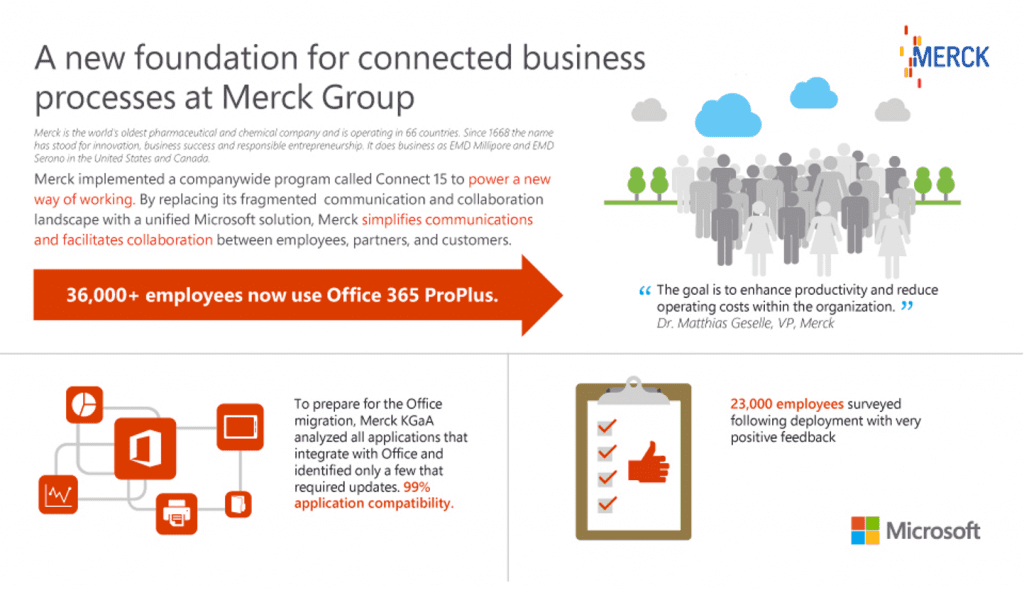A new foundation for connected business processes at a German pharmaceutical and chemical company
Today’s Office 365 post was written by Dr. Matthias Geselle, a Vice President, member of the IT leadership team at Merck. Merck is the world’s oldest pharmaceutical and chemical company and is operating in 66 countries. Since 1668 the name has stood for innovation, business success and responsible entrepreneurship. It does business as EMD Millipore and EMD Serono in the United States and Canada.
Connect 15 is Merck’s companywide program to replace the fragmented landscape of collaboration, messaging, and communication tools into a unified Microsoft technology, which simplifies communications around the world and facilitates collaboration between our employees, partners, and customers. When everything is implemented Connect 15 will enable a new way of working within Merck. The first step in our initiative was updating our Office suite from Office 2007 to Office 365 ProPlus, followed by a change from Lotus Notes to Exchange for email and from IBM Sametime to Microsoft Lync for chat.
The first rollout of Office 365 took place in June 2014, and as of March 4, 2015 we have migrated more than 36,000 employees to Office 365 ProPlus and 28,500 users to Exchange. We plan to finish the rollout by mid-April. That means a total of 11 months for the whole rollout.
The goal in the initial phase was to ensure a smooth transition to the new technology and we accomplished that. We conducted a survey of the first 23,000 users who migrated to Office 365 ProPlus, Exchange and Lync, and received very positive feedback about the rollout and the products. We knew we were off to a great start. Our employees are looking forward to additional Lync capabilities such as audio and video conferencing functionalities as well as the new digital workplace based on SharePoint for communications and collaboration.
Merck is using Office 365 to replace a group of disconnected technologies including Lotus Notes, Sametime, and WebEx, that we had deployed over the years. With the Microsoft solution, we will have a completely new way of working together once all components of the Connect 15 program are rolled out. Our employees are realizing that this change is much larger than just getting a new version of Office or a new email system. Instead of working on documents, we’ll be collaborating on them. The goal is to enhance productivity and reduce operating costs within the organization.
To prepare for the Office migration we analyzed our applications that integrate with Office, and were positively surprised to identify only a few that required updates. We took advantage of the option to leave Office 2007 installed in a side-by-side configuration with Office 365 ProPlus for about one percent of our employees who use applications that are being updated.
Using Group Policy to deploy Office 365 ProPlus, we rolled out the software by function within Germany, and by country in the rest of the world. In each location we trained a member of the IT staff to act as a change agent. When employees received their Office update and especially when they were migrated from Lotus Notes to Outlook, the change agents were there to answer questions. In addition to providing the onsite staff specialists, we developed extensive eLearning courses, classroom training, did marketing events, and produced a series of FAQ documents and other communications.
The next phase of the program, set to begin in April of 2015, will really focus on scaling up Office 365, especially the Lync and SharePoint capabilities. Our change agents will hold events to demonstrate the new way of working and reinforce the cultural change, and then work with individual teams to create tailored solutions. We see Microsoft OneDrive for Business as a major catalyst in this next phase. OneDrive makes it possible to share and collaborate on documents from any location, using any device. We are looking forward to continue our journey with great success as we have seen with our Office 365 ProPlus deployment.





